
Your PDA can help you code more efficiently and accurately.
Fam Pract Manag. 2002;9(5):33-37
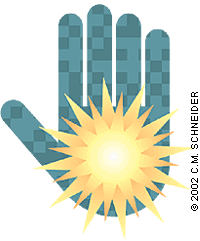
With so many diverse rules to follow, coding and billing patient visits consumes more time than most physicians have. Fortunately, there is a faster, more accurate way to get the job done and it’s literally in the palm of your hand if you own a personal digital assistant (PDA). All it takes is a willingness to experiment with your PDA and some familiarity with coding and billing software.
In this article, I will introduce you to some of the more well-known programs and describe what they can do for you. Unless noted otherwise, I have chosen to focus on software programs designed for the Palm OS platform, since it is the most widely used. For more information on software for the competing Pocket PC platform, go to Medical Pocket PC (www.medicalpocketpc.com/software) or my Web site, The Family Physician’s Guide to Handheld Computer Software (www.fphandheld.com).
Choosing ICD-9 or CPT procedure codes
Although many software programs are marketed as having “charge capture” capabilities, these capabilities vary widely. Some merely offer a list of codes from which to choose; others actually lead you through the documentation guidelines and use your responses to select codes for you.
CodeMeister (www.meistermed.com) is perhaps the best-known program for simply locating diagnosis and procedure codes. Because it was written by a family physician, it’s very family-physician friendly. You can locate ICD-9 or CPT codes at the point of care by either browsing through the coding hierarchy (see figure 1A) or by searching for key words using the Find function (see figure 1B). I generally just use the Find function. Using your key word, the program will provide you with a selection of codes – specific to the fifth digit, when required (see figure 1C). Version 2.02 includes the most recent diagnosis and procedure codes (including the 2002 updates) and costs $19.95 for a single user. A free trial is also available. You must have the iSilo document reader program installed on your PDA for CodeMeister to function. The iSilo program is available at www.isilo.com. A free 30-day trial period is offered, after which the software can be purchased for $17.50.
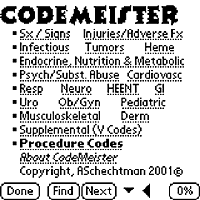
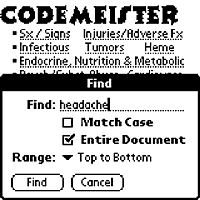
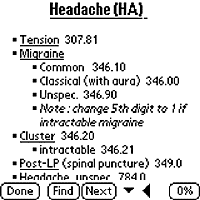
Meeting medical necessity requirements
How many times have you had a claim denied because the diagnosis code you chose didn’t support the procedure code you submitted? As you’re well aware, the Centers for Medicare & Medicaid Services (CMS) and most private payers will only reimburse you for services they consider medically necessary. One way to avoid having claims denied for this reason is to review your state’s local medical review policies (LMRPs) and to make sure the diagnosis codes you choose support the procedure codes you submit.
KEY POINTS
With coding and billing software for the PDA, physicians can enter their own codes at the point of care, improving coding accuracy and reimbursement rates.
Charge capture capabilities vary widely among software programs. Some programs are simply lists of codes while others can perform more sophisticated tasks such as checking for billing errors or automatically submitting claims.
Some coding and billing software also automatically audits physicians’ coding for errors, reducing the amount of undercoding or overcoding that occurs and increasing revenue.
ClearCoder software (www.mdeverywhere.com/products/everyreference/clearcoder.asp) does this for you. ClearCoder offers specialty-specific lists of CPT and ICD-9 codes, with bullet points next to each code for which your state’s LMRPs have a medical necessity policy (see figure 2A). Clicking on a bulleted CPT code will give you a list of all the diagnoses that meet your medical necessity requirements according to the LMRPs in your area (see figure 2B). Clicking on a bulleted ICD-9 code will give you a list of all the procedures that it supports. The ClearCoder software costs about $500 for a single user and includes quarterly updates that incorporate changes in each state’s LMRPs. Up to eight specialty-specific lists of codes (requiring 150K memory each) can be downloaded onto one palm-top computer.
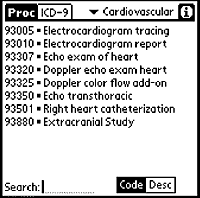
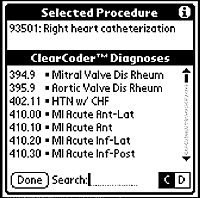
Analyzing E/M coding levels
Correct evaluation and management (E/M) coding isn’t easy, but STAT E&M Coder software (www.statcoder.com) makes the process more straightforward with automated checklists that count the documentation elements of a patient visit for you. There are separate checklists (i.e., screens) for history, exam (A and B) and medical decision making. As you dictate or write your note, simply tap your stylus on the items you are documenting and the “scoreboard” at the top of the screen calculates the level of service the documentation supports. The box in the middle of the scoreboard suggests the last three digits of the appropriate CPT code (see figure 3). Unfortunately, STAT E&M Coder is really not quick enough to use during all patient encounters. I use it when I’m not quite sure what level of service to bill and to periodically audit my coding.
Stat E&M Coder also provides hints for improving your documentation to assure the highest appropriate coding level. Another nice feature of this software is its ability to generate a memo documenting how the coding level was achieved. This memo can be saved in your PDA’s Memo Pad function and can be transferred or synchronized with your desktop computer using the hot sync function. Or, if you choose, you can download PalmPrint ($39.95 for a single copy,www.stevenscreek.com/palm/palmprint.shtml) or another printing application and print a copy of the memo directly from your PDA to a printer. The printed memo could then be kept with the billing sheet for documentation purposes should you ever be audited. STAT E&M Coder uses approximately 180K of memory and costs $75 for a two-year license. A free trial is available.
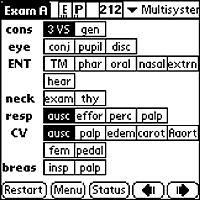
Keeping track of patient billing records
Many physicians keep patient information on sticky notes or 3-x-5-inch cards when they’re doing rounds. This information can easily get misplaced or forgotten in the pocket of a lab coat and never make it into the billing system. A better option that’s just as portable is adding patient billing software to your PDA. PocketBilling 2.02 by PocketMed (www.pocketmed.org) allows users to code E/M services and procedures and to track patients at the point of care. The database program, written by a family physician, allows users to enter patient information on allergies, diagnoses, medications, past surgical history and past social history. Customizable pop-up screens make inputting data easier. To enter a visit charge, you would simply click on “Visits” then select “New,” which brings up a screen with a selection of visit types (see figure 4A). Once you choose a visit type, a screen with a selection of corresponding codes appears (see figure 4B). Highlighting the appropriate code automatically enters it into the patient record.
MORE PALM OS CODING AND BILLING SOFTWARE
CarePad (www.intehealth.com/carepad.htm). Patient billing and information database. Cost is based on a peruser monthly subscription fee. The CareServ wireless portal enables two-way wireless connectivity between existing computer systems and the CarePad.
FPM Short List of ICD-9 Codes. (www.aafp.org/fpm/icd9.html). Free. Requires a document reader (i.e., a program for displaying doc files) such as TealDoc (www.tealpoint.com/softdoc.htm). A longer list of codes common in family practice is also available.
Hospital Rounds Database 3.0. (www.solersys.com/hospital_rounds_database_3.0.htm). Inpatient billing and clinical record database. $29.95. Free demo available. Requires HanDBase application (www.ddhsoftware.com/handbase.html).
ICD-Notes (www.med-notes.com/icd-notes.htm). Searchable ICD-9 coding resource. $20. Requires 922K memory.
MD Coder (www.mobiledesigntech.com/product/index.htm). Specialty-specific patient tracking and charge-capture application. $149. Free 14-day trial available.
Mobile MedData Professional (www.medcomsys.com/source/product/index.asp). Single-user hand-held patient tracking software that interfaces with practice management and third-party billing software programs. $599. Free 30-day trial available. Requires 60MB of memory.
A “personal” edition is also available that does not integrate with desktop or billing systems. $49.99. Requires 500K memory.
Pocket CPT Coding Guide and Reference (www.pocketpublishing.com). CPT and E/M coding resource. $149. Requires 780K memory.
Pocket Patient Billing 4.06 (pocketpa.imrac.com). Patient tracking and charge capture sofware with CPT and ICD-9 codes categorized by specialty. $199. Free 30-day trial. Requires 11.2MB memory.
PocketPractitionerOffice (www.pocketmedtools.com). Upgraded version of PocketPractitioner patient tracking software, including a complete PC desktop application and CPT and ICD-9 codes. $129. Free 30-day trial available. Requires 0.3MB memory.
STAT CPT Coder (www.statcoder.com/cpt.htm). Searchable CPT resource. $50. Free trial available. Requires 331K memory and TealInfo database (www.tealpoint.com).
STAT ICD-9 Coder (www.statcoder.com/icd9.htm). Searchable ICD-9 resource. $29. Free trial available. Requires TealInfo and TealDoc database (www.tealpoint.com).
topsE&M Coder (www.e-mds.com/emds/prodserv/tops_emcoder.html). Calculates E/M coding levels. Built-in text helps prevent missing documentation necessary to code at a higher E/M level. $49.95. Free trial available.
ZapBill (www.zapmed.com/pages/zapbill.html). Patient tracking and billing record with searchable ICD-9 and CPT coding lists. $89. Free trial available. Requires 198K memory.
ZapCode (www.zapmed.com/pages/zapcode.html). Analyzes E/M coding levels and offers coding tips. $69. Free trial available. Requires 114K memory.
ZapICD (www.zapmed.com/pages/zapicd.html). Searchable ICD-9 resource. $25. Free trial available.
Once you have the information on your PDA, you can print it out using a printing application such as PalmPrint, which was mentioned earlier, or you can use the infrared beaming feature to transfer it to the next physician covering your patients. The software design allows transfer of the information in your patient database, but not the billing portion of the record. That way, there’s no confusion about who bills for each patient visit. PocketBilling 2.02 costs $49.99. A PocketPC version is also available.
PocketMed also makes PocketBilling Office Suite ($95). It includes the palm-top PocketBilling software plus a desktop computer version that lets you directly synchronize information between the two. Plus, it enables you to export information to Microsoft Access and Microsoft Excel.
Submitting claims automatically
The more sophisticated charge-capture software on the market compiles billing information for claims submission, checks for billing errors and even directly submits your claims. This is an emerging area in hand-held computer software technology and typically requires some form of server for data processing. Server options include installing a local server specifically for the practice site or working with an Application Service Provider (ASP), which uses a Web-based server to store data off site. Advantages to having a local server include greater speed and more control over security, whereas use of the ASP model requires no investment in server hardware. Because of the lower start-up costs, small practices tend to choose the ASP model, while larger organizations often prefer housing their information on their own servers.
FPM ARTICLES ON PALM-TOP COMPUTERS
Web-based software. EveryCharge (www.mdeverywhere.com/products/everycharge/index.asp) offers an ASP software package for both Palm OS and Pocket PC computers. With the EveryCharge service, your palm-top computer is synchronized with your practice management system so that your daily outpatient schedule and updated inpatient census is available on your PDA screen (see figure 5). Patient diagnoses and procedure codes can all be entered at the point of care. This information can be entered manually or by using an attachment on your PDA to scan bar codes (both the attachment and the bar codes are provided by the company) identifying common diagnoses and procedures. In addition, EveryCharge includes a rules” engine “rules” engine to identify and correct billing errors at the time they occur. The hot sync function transmits the charges via the Internet to EveryCharge’s data center. Designated users can continue to access and edit the data by logging into the data center via the Internet. Charges are batched and sent to the practice’s billing system so they can be forwarded to payers the same day. To comply with the privacy and security regulations mandated by the Health Insurance Portability and Accountability Act (HIPAA), EveryCharge includes an authentication feature, automatic locking to protect patient information stored in the PDA and automatic encryption.
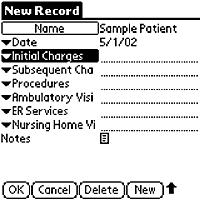
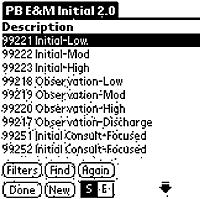
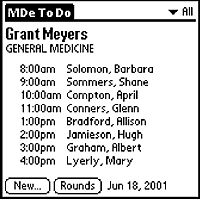
EveryCharge is provided for a monthly service fee of $300 per physician. (This amount is the list price. Larger practices may be eligible for a lower per-physician fee.) Physicians are provided with PDAs with bar-code scanning capabilities. The company also offers the same service using a local server.
Local server-based software. Many physicians are familiar with PatientKeeper Personal, the patient tracking software. The company also has a billing software program called ChargeKeeper (www.patientkeeper.com/solutions/chargekeeper.asp). Both a Palm OS and Pocket PC version of Charge-Keeper are available. Both require installation of a local server to process and store data and to interact with a hospital database and/or a practice patient scheduling system. Like EveryCharge, ChargeKeeper features the ability to input patient diagnoses and charges at the point of care and a rules engine to search for coding errors. Synchronizing the PDA with a desktop computer sends charges to the server where they can be accessed by your authorized billing staff. Staff can then edit them, recheck for coding errors, and delete or post charges to the billing system. Charge-Keeper also offers the option of sending a correct charge directly from the PDA to the billing system or to a “holding bin” for further review. The program automatically sends all charges with “fatal errors” directly to the holding bin for correction. To comply with HIPAA, the ChargeKeeper software includes authentication and encryption features as well as an audit trail that tracks each time a charge is submitted, viewed, deleted or posted.
ChargeKeeper is designed for large group practices, but the company plans to release similar software for small group practices. There is a licensing fee and a monthly connectivity fee. Contact PatientKeeper directly for specific cost information.
Generating charges via an EMR system
It would be ideal to have stand-alone software that would analyze progress notes and determine appropriate ICD-9, CPT and E/M coding for us, but hand-held software technology hasn’t progressed to that point yet. However, this feature – called automatic charge generation – is currently available on many electronic medical records (EMR) systems, several of which also offer a hand-held interface option allowing users to access and/or input data into the EMR system. The trade-off is that this feature is generally more time-consuming to use than dictating or writing progress notes the good old-fashioned way.
Future solutions
PDA software currently on the market can alleviate many of our billing concerns, but no software yet exists that combines all the functionality mentioned in this article into a single stand-alone product. Another concern is the time-consuming task of data entry. As technology improves, hand-held software of the future will likely be able to follow voice commands and automatically convert dictated notes into text.
With that said, I still encourage you to try some of the coding and billing software currently on the market. You won’t be wasting your money. Using coding and billing software has taught me how to code more accurately. And in a situation where I’m not sure how I should be coding, I have all the help I need right there in the palm of my hand.